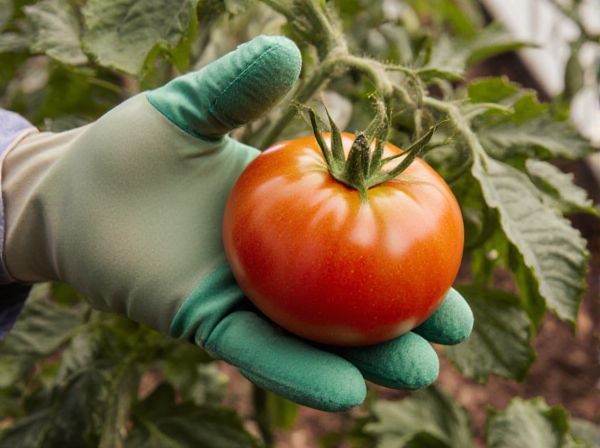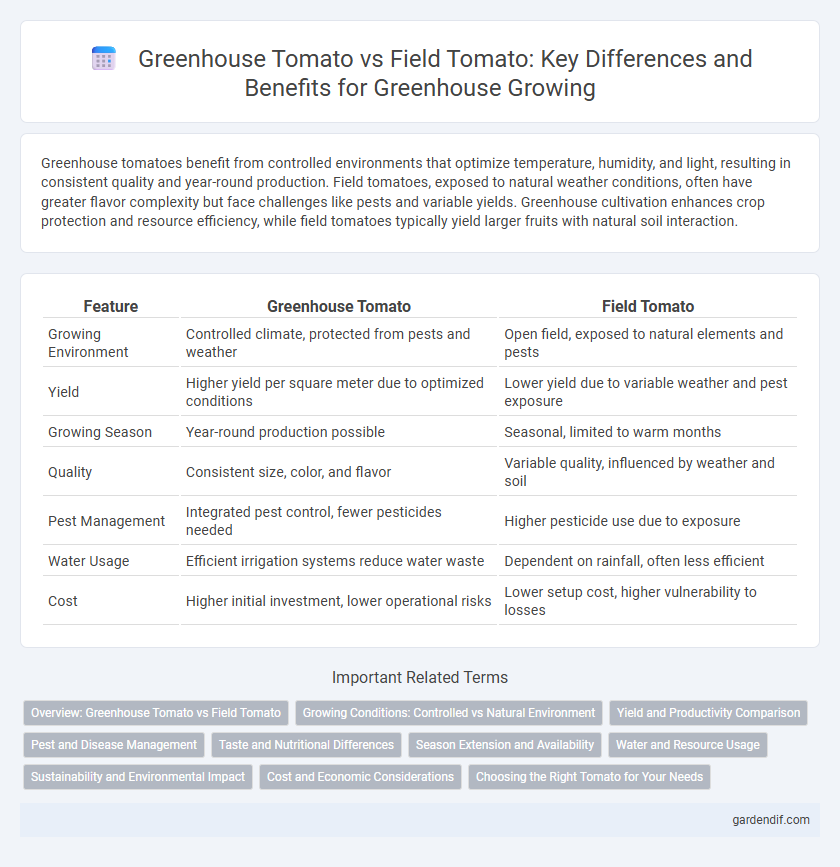
Greenhouse Tomato vs Field Tomato Illustration
Greenhouse tomatoes benefit from controlled environments that optimize temperature, humidity, and light, resulting in consistent quality and year-round production. Field tomatoes, exposed to natural weather conditions, often have greater flavor complexity but face challenges like pests and variable yields. Greenhouse cultivation enhances crop protection and resource efficiency, while field tomatoes typically yield larger fruits with natural soil interaction.
Table of Comparison
| Feature | Greenhouse Tomato | Field Tomato |
|---|---|---|
| Growing Environment | Controlled climate, protected from pests and weather | Open field, exposed to natural elements and pests |
| Yield | Higher yield per square meter due to optimized conditions | Lower yield due to variable weather and pest exposure |
| Growing Season | Year-round production possible | Seasonal, limited to warm months |
| Quality | Consistent size, color, and flavor | Variable quality, influenced by weather and soil |
| Pest Management | Integrated pest control, fewer pesticides needed | Higher pesticide use due to exposure |
| Water Usage | Efficient irrigation systems reduce water waste | Dependent on rainfall, often less efficient |
| Cost | Higher initial investment, lower operational risks | Lower setup cost, higher vulnerability to losses |
Overview: Greenhouse Tomato vs Field Tomato
Greenhouse tomatoes are typically cultivated in controlled environments, enabling year-round production with optimized temperature, humidity, and light, which results in consistent quality and higher yields compared to field tomatoes. Field tomatoes rely on natural weather conditions, making their growth cycle seasonal and more susceptible to pests, diseases, and environmental stress, often affecting fruit size and taste variability. The controlled environment of greenhouse tomatoes often leads to better water use efficiency and reduced pesticide application, contributing to sustainable agriculture practices.
Growing Conditions: Controlled vs Natural Environment
Greenhouse tomatoes thrive in controlled environments where temperature, humidity, and light are precisely regulated to optimize growth and yield year-round. Field tomatoes depend on natural conditions, including variable sunlight, temperature fluctuations, and rainfall, which can lead to inconsistent fruit quality and harvesting schedules. The controlled climate of greenhouses minimizes pests and diseases, promoting healthier plants compared to the unpredictable challenges faced by field-grown tomatoes.
Yield and Productivity Comparison
Greenhouse tomatoes typically produce higher yields than field tomatoes due to controlled environmental conditions that optimize temperature, humidity, and light for plant growth. The consistent climate inside greenhouses extends the growing season and reduces pest-related losses, resulting in improved productivity per square meter. In contrast, field tomatoes are more susceptible to weather fluctuations and pests, which can significantly lower overall yield and affect fruit quality.
Pest and Disease Management
Greenhouse tomatoes benefit from a controlled environment that significantly reduces exposure to common field pests such as whiteflies, aphids, and thrips, decreasing the reliance on chemical pesticides. The enclosed space in greenhouses allows for integrated pest management strategies like biological control using predatory insects and disease-free propagation material, limiting the spread of fungal and bacterial infections. In contrast, field tomatoes face higher risks from soil-borne diseases and variable weather conditions that exacerbate pest infestations and disease outbreaks, often necessitating more frequent pesticide applications and crop rotations.
Taste and Nutritional Differences
Greenhouse tomatoes typically exhibit a more consistent sweetness and balanced acidity due to controlled growing conditions, enhancing flavor reliability compared to field tomatoes. Field tomatoes often have a more robust, complex taste profile influenced by soil variability and natural weather, which some consumers prefer for its authenticity. Nutritionally, greenhouse tomatoes may have slightly lower levels of antioxidants like lycopene and vitamin C, as sunlight exposure is limited, while field tomatoes generally possess higher concentrations of these nutrients, contributing to their health benefits.
Season Extension and Availability
Greenhouse tomatoes offer significant advantages in season extension and availability compared to field tomatoes, enabling year-round production regardless of outdoor weather conditions. Controlled environments in greenhouses optimize temperature, humidity, and light, resulting in earlier harvests and prolonged growing seasons. Field tomatoes, dependent on natural climatic conditions, typically have a limited growing season and availability constrained to late spring through early fall.
Water and Resource Usage
Greenhouse tomatoes require significantly less water than field tomatoes, using up to 30% less due to controlled irrigation systems such as drip irrigation, which minimizes evaporation and runoff. Resource efficiency in greenhouse tomato production is enhanced by optimized nutrient delivery and climate control, reducing waste and improving yield per unit of input. Field tomatoes often depend on natural rainfall and extensive water use, leading to higher variability in water application and lower resource use efficiency compared to the highly regulated greenhouse environment.
Sustainability and Environmental Impact
Greenhouse tomatoes typically have a lower environmental impact compared to field tomatoes due to controlled resource usage, including optimized water consumption and reduced pesticide application. Their sustainable production methods result in higher yield per square meter, minimizing land use and soil degradation associated with traditional open-field farming. Energy-efficient greenhouse technology further reduces carbon emissions, making greenhouse tomato cultivation a more sustainable choice in modern agriculture.
Cost and Economic Considerations
Greenhouse tomatoes typically incur higher initial setup and operational costs compared to field tomatoes due to climate control systems, energy consumption, and labor intensity. However, the controlled environment allows for extended growing seasons and higher yields per square meter, often resulting in greater profitability despite the increased expenses. Economic considerations also include market demand for premium-quality tomatoes and reduced crop losses from pests and weather, which can justify the higher cost structure of greenhouse production.
Choosing the Right Tomato for Your Needs
Greenhouse tomatoes offer a controlled environment that ensures consistent quality, longer growing seasons, and reduced pest exposure compared to field tomatoes. Field tomatoes typically yield larger fruit with a more intense natural flavor but are more susceptible to weather variations and pests. Selecting between greenhouse and field tomatoes depends on prioritizing consistency and extended production or valuing natural flavor intensity and traditional cultivation methods.
Greenhouse Tomato vs Field Tomato Infographic

 gardendif.com
gardendif.com